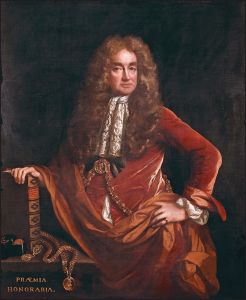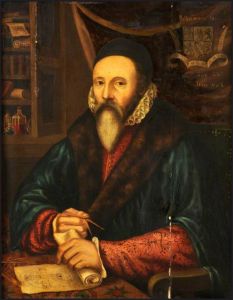
Anonymous English Artist, John Dee, c. 1594. Wellcome Library; Supplied by The Public Catalogue Foundation
According to the source given at Astrotheme, John Dee was born in London [Tower Ward] England 13 Jul 1527 4:02:00 PM. He died December 1608, Mortlake, Surrey [now in Richmond upon Thames.
Several years ago I published a brief article on the Nativity of John Dee. At that time, I questioned the accuracy of the chart using house systems other than Whole Sign in particular. I had not yet developed my current interest in sidereal astrology, but even then I sensed problems with the most widely circulated chart. More recently, I had cause to reconsider the nativity in light of my current interest in Persian astrology and the Sassanian Ayanamsa.
There were particularly strong cues that motivated my investigation As is the case on the vast majority of popular astrological sites on the web, the chart is presented employing the tropical zodiac and Placidus houses. Here I’m using Whole Signs for both the tropical and sidereal chart.
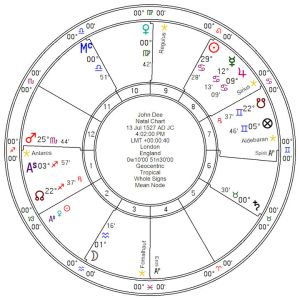
John Dee 13 Jul 1527 AD JC 4:02:00 PM London, England 0w10’00 51n30 00 LMT +00:00:40
I note that Jupiter and Mercury are posited in the house of open enemies, the MC is disposited by Venus in her Fall and there is no support from the Eleventh House. We have a man who had eight children, but his Fifth House is in an infertile house, home to Saturn, and disposited by a barren Venus in her Fall. The Sun in the Eighth may be interpreted as plausible support for the finding of ‘a spy with powerful occult interests,’ but much of the chart doesn’t describe what we know to be the case regarding Dee. Mars conjunct the Fixed Star Antares loses something essential in the Tropical chart by being projected onto the constellation Sagittarius, when in fact the star is the Heart of the Scorpion,
We would expect a strong Mercurial element not shown in the tropical chart. Mars in Scorpio rather than the tropical Sagittarius is also a better fit in my view. Given these rather obvious differences, it surprises me that this chart has not been explored more than it has. particularly with respect to the powerful Mercurial energy and all that this implies. In short, the tropical chart appears to miss the mark. The writer at Seven Stars Astrology rightly states: “The zodiac choice is particularly complex in the context of Hellenistic astrology.
The zodiac was borrowed from the Babylonians but new Hellenistic doctrines, including sign associations, arose at a time when sidereal and tropical zodiacs nearly coincided. Sign qualities in the Hellenistic period pertained to the seasonal calendar as well as the images of the constellations. Furthermore, some Hellenistic astrologers, ignorant of precession, including Thrasyllus and Vettius Valens, used the Babylonian zodiac, sometimes even into the 4th century CE. Meanwhile, Claudius Ptolemy of the [3rd century] CE, cognizant of precession, set the stage for the widespread adoption of the tropical zodiac.” In the sidereal chart, I’m struck by the refined nature of Mars and the position of Mercury as Doryphory with Sirius in the stealthy and occult-oriented eighth house.
To the best of my knowledge, this Nativity has not been read using a sidereal zodiac. 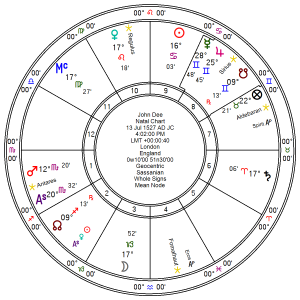 The Sun remains in Cancer but is now in the ninth house, as would be expected of someone who travelled widely in the pursuit of philosophical knowledge. Notably, Dee was perhaps the foremost expert on marine navigation of his time. and is justly credited with being influential in England’s developing naval prominence, most famously regarding his alleged role in the defeat of the Spanish Armada, but in a larger sense the firm idea of an Empire based on naval dominance.
The Sun remains in Cancer but is now in the ninth house, as would be expected of someone who travelled widely in the pursuit of philosophical knowledge. Notably, Dee was perhaps the foremost expert on marine navigation of his time. and is justly credited with being influential in England’s developing naval prominence, most famously regarding his alleged role in the defeat of the Spanish Armada, but in a larger sense the firm idea of an Empire based on naval dominance.
Mars is not only the Lord of the Geniture but also the chart Almuten. Given these rather obvious differences, it surprises me that this chart has not been explored more than it has. particularly with respect to the powerful Mercurial energy and all that this implies. Mars is not only the Lord of the Geniture but also the chart Almuten. The Hour belongs to Mars, the Day to Saturn. This is a Diurnal, Full Moon chart, with the Luni-Solar elements on the 3/9 axis. The Moon is in the House of the Goddess and the Sun in the House of the Sun God. Luna is in the Decan of Mars and the Bounds of Venus. The Sun is in the Decan and Bounds of Mercury. Mars has the greatest Essential Dignity in the chart and Venus has the highest Accidental dignity.
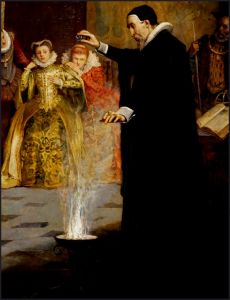
John Dee Performing an Experiment before Elizabeth I – Henry Gillard Glindoni (1852-1913), -Public Domain via Wikimedia Commons
Some elements of the chart are almost absurdly literal. In the 9th House, the Sun is informing and influencing the Queen – Venus in Leo in the 10th. Dee’s Mars in Scorpio conjunct Antares is applying to the Sun. Mercurial Virgo is on the MC. Mercury has by far the greatest count of dignities. If we add Essential and Accidental dignities, we have a total of 17 points. Mercury is Free of the Beams and Occidental. Moreover, this theme repeats with Jupiter and Mercury now in Gemini in the 8th House of the occult, speaking of deep research and a fascination with magic.
Dee’s now well-known writings on Angel Magic were appropriately concealed. In his introduction to John Dee’s Five Books of Mystery, Joseph S, Person writes: “The secret writings of John Dee, one of the leading scientists and occultists in Elizabethan England, record in minute detail his researches into the occult. They were discovered in a hidden compartment of an old chest along with various magical implements. Although the angels made him swear never to reveal these doctrines to anyone not sanctioned by them, he complained, “If no man, by no means, shall perceive anything hereof by me, I would think that I should not do well.” Nevertheless, these pages were carefully concealed and nearly lost forever.” Their recovery was in no small part due to Elias Ashmole’s interest in the occult in general and John Dee in particular.
“Records indicate that Elias Ashmole had taken an interest in John Dee by the late 1640s. During this time, Ashmole contacted Dee’s son, Arthur, and asked if he could provide Ashmole with more information about his father. Arthur Dee responded by providing him with biographical information about his father and by giving Ashmole John Dee’s diaries. Although Ashmole collected the manuscripts of numerous scholars, he maintained a particular interest in Dr. John Dee.
In addition to Dee’s works on alchemy and astrology, Ashmole collected his manuscripts on the study of mathematics and his records of English weather during the Tudor era. During the late 17th century, Ashmole was given more of John Dee’s manuscripts by Thomas Wale, who discovered them while his domestic servant was using the documents to line pie dishes.” See article in the Ashmolean collection.
Some will baulk at this exercise; however, a sidereal reading of Dee’s nativity yields a wealth of information that accords with what we know about John Dee not available in the tropical chart. I would only ask that you exercise a “willing suspension of disbelief” long enough to assess what has been uncovered.

